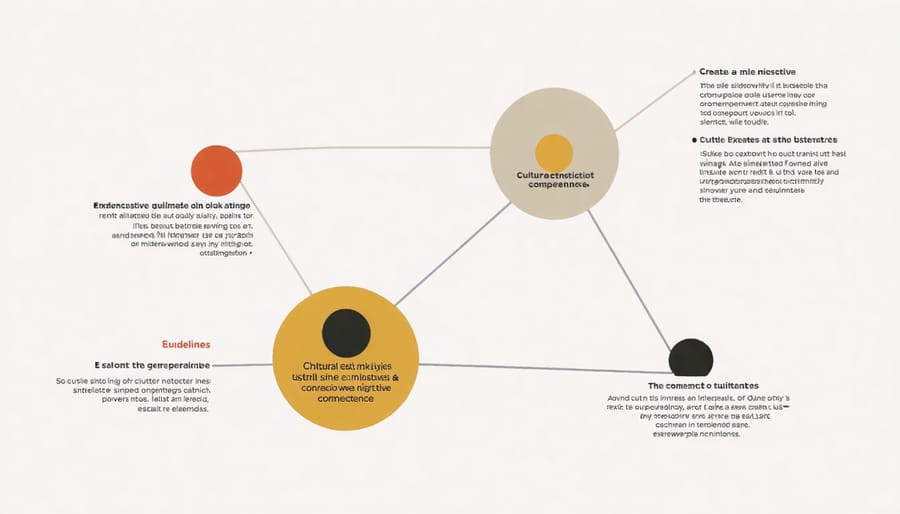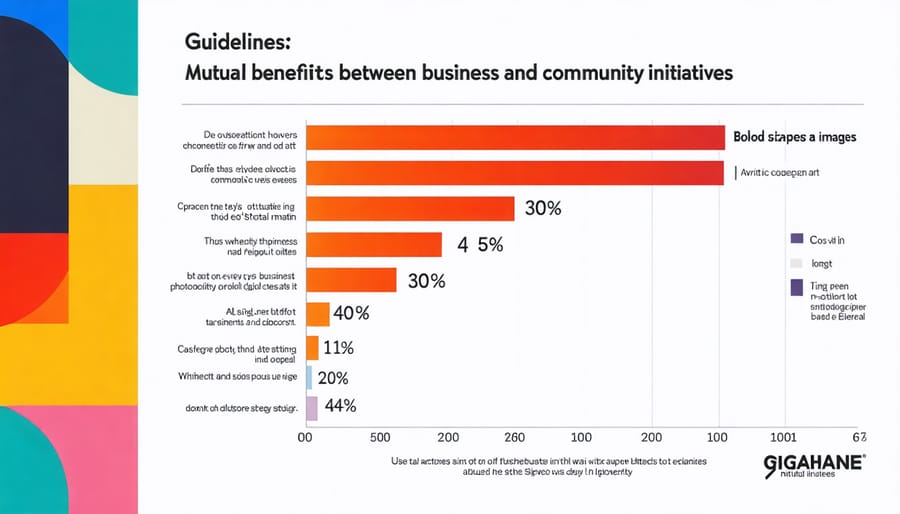Transform your community engagement strategy by mastering nine essential principles that drive meaningful impact and sustainable partnerships. In today’s interconnected business landscape, effective corporate governance practices must extend beyond boardroom decisions to create lasting community relationships.
Successful Canadian organizations demonstrate that strategic community engagement isn’t just about corporate social responsibility—it’s a fundamental business imperative that builds trust, enhances reputation, and creates shared value. From Vancouver’s thriving tech sector to Toronto’s financial district, companies leveraging these principles consistently outperform their peers in stakeholder relations and social impact metrics.
Whether you’re a seasoned executive or an emerging business leader, these nine principles provide a comprehensive framework for developing, implementing, and measuring community engagement initiatives. They combine decades of practical experience with cutting-edge stakeholder management techniques, offering a roadmap for organizations of all sizes to create meaningful community partnerships.
By implementing these principles, your organization will develop stronger community bonds, enhance operational effectiveness, and create sustainable value for all stakeholders. This guide distills complex engagement strategies into actionable steps, ensuring your community initiatives deliver measurable results while strengthening your organization’s social license to operate.
Join leading Canadian businesses in revolutionizing how they connect with and serve their communities. Let’s explore these nine foundational principles that will transform your approach to community engagement.

Authentic Community Partnership
Building Trust Through Transparency
Transparency forms the bedrock of successful community engagement, serving as a crucial element in building lasting relationships with stakeholders. Canadian organizations that maintain open lines of communication and share both successes and challenges consistently report stronger community bonds and more effective partnerships.
Leading companies like Vancouver-based Teck Resources demonstrate this principle through regular community updates, detailed environmental reports, and accessible feedback channels. By sharing decision-making processes and being forthright about potential impacts, organizations can foster trust and credibility with their community partners.
To build transparency effectively, organizations should:
– Provide regular updates through multiple channels
– Share both positive outcomes and areas for improvement
– Maintain consistent documentation of engagement activities
– Respond promptly to community concerns
– Create accessible feedback mechanisms
According to the Canadian Council for Aboriginal Business, organizations that prioritize transparent communication are 60% more likely to maintain long-term community partnerships. This approach not only strengthens relationships but also reduces the risk of misunderstandings and conflicts, creating a foundation for sustainable community engagement.
Remember that transparency isn’t just about sharing information—it’s about creating an environment where stakeholders feel valued, heard, and respected.
Long-term Commitment Strategy
Successful community engagement requires more than short-term initiatives or one-off projects. Organizations that achieve meaningful impact understand that responsible business transformation demands sustained, long-term commitment to community partnerships. Leading Canadian companies like TD Bank and Vancity demonstrate how multi-year community programs create lasting positive change through consistent involvement and resource allocation.
To build effective long-term engagement, organizations should establish dedicated teams, secure stable funding mechanisms, and develop clear metrics to track progress over time. This approach allows for deeper relationship building, better understanding of community needs, and the ability to adjust strategies based on feedback and results.
Industry experts recommend committing to a minimum three-to-five-year timeline for community initiatives. This timeframe enables organizations to move beyond surface-level engagement to create sustainable programs that deliver measurable value to both the community and business stakeholders. Regular communication, transparency about long-term goals, and celebration of shared achievements help maintain momentum and strengthen community trust over time.

Cultural Competence and Respect
Understanding Local Context
Before implementing any community engagement initiatives, thoroughly researching and understanding the local context is crucial for success. This involves analyzing the community’s demographic makeup, cultural values, economic conditions, and existing social structures. Canadian communities are diverse, with unique characteristics that require tailored approaches.
Start by gathering both quantitative and qualitative data about the community. Review census data, local economic indicators, and community health assessments. Equally important is connecting with local leaders, cultural organizations, and community groups to gain insights into informal power structures and relationship dynamics.
Consider historical context and past experiences with similar initiatives. As noted by the Vancouver-based community engagement expert Sarah Thompson, “Communities remember both positive and negative interactions with organizations. Understanding this history helps build trust and avoid past mistakes.”
Remember that communities are not monolithic. Pay attention to different subgroups, their specific needs, and how they interact. This understanding helps create inclusive engagement strategies that resonate with all community members. Regular environmental scanning and community mapping exercises ensure your knowledge stays current as community dynamics evolve.
Inclusive Decision-Making
Successful community engagement hinges on creating decision-making processes that welcome and value diverse perspectives. Canadian organizations leading in this area establish multiple channels for gathering input, from traditional town halls to digital platforms, ensuring accessibility for all community members.
Consider establishing advisory committees that reflect your community’s demographic makeup, including representatives from Indigenous communities, newcomers, youth, seniors, and other key stakeholder groups. Toronto-based social enterprise Leader’s Digest demonstrates this principle effectively by rotating committee leadership roles among different community segments.
Digital tools can complement in-person engagement, but shouldn’t be the only option. The City of Vancouver’s mixed-method approach combines online surveys, mobile polling stations, and multilingual community ambassadors to reach traditionally underrepresented groups.
To maintain transparency and accountability, document how community input influences final decisions and communicate outcomes back to stakeholders. This feedback loop builds trust and encourages continued participation. Remember that inclusive decision-making isn’t just about gathering diverse opinions—it’s about actively incorporating these perspectives into your strategy and operations.
Consider implementing regular review periods to assess whether your engagement methods truly reach all community segments and adjust your approach accordingly.
Mutual Benefit Creation
Sustainable Value Exchange
Effective community engagement must create value for all stakeholders involved. This reciprocal relationship forms the foundation of sustainable business practices and long-term community partnerships. Organizations should establish clear metrics to measure both the community benefits and business outcomes of their engagement initiatives.
Consider implementing a balanced scorecard approach that tracks social impact indicators alongside business performance metrics. This might include measuring community employment rates, local economic growth, and environmental improvements, while also monitoring brand reputation, customer loyalty, and market share.
Canadian companies like Mountain Equipment Co-op (MEC) exemplify this principle through their community grants program, which supports outdoor recreation and conservation while building brand loyalty and market presence. The key is to design initiatives where business success naturally aligns with community prosperity.
To ensure sustainable value exchange, regularly assess and adjust your engagement strategies through stakeholder feedback, impact assessments, and transparent reporting. This approach helps maintain trust and demonstrates genuine commitment to mutual benefit.
Impact Measurement
Measuring the impact of community engagement initiatives is crucial for demonstrating value and guiding future strategies. Successful Canadian organizations employ both quantitative and qualitative metrics to evaluate their community programs. Key performance indicators typically include volunteer participation rates, community feedback scores, and social return on investment (SROI) calculations.
Leading companies like TD Bank and TELUS have developed comprehensive measurement frameworks that track both immediate outputs and long-term outcomes. These frameworks often incorporate community surveys, stakeholder interviews, and data analytics to provide a complete picture of engagement effectiveness.
To implement effective measurement practices:
– Establish clear baseline metrics before launching initiatives
– Conduct regular progress assessments
– Document both tangible and intangible benefits
– Use standardized reporting tools
– Share results with stakeholders transparently
The Vancouver Foundation’s approach exemplifies best practices by combining traditional metrics with innovative social impact measurements. Their framework tracks community well-being indicators alongside program-specific outcomes, providing valuable insights for other organizations to follow.
Remember that measurement should be ongoing and adaptable, allowing for continuous improvement of engagement strategies based on concrete data and community feedback.

Capacity Building and Empowerment
Effective community engagement requires a strong foundation in capacity building and empowerment. Just as successful organizations focus on building thriving teams, communities need support to develop their skills, knowledge, and resources.
Canadian businesses have demonstrated remarkable success in this area through strategic initiatives that prioritize local talent development. For instance, Vancouver-based tech companies have established coding bootcamps in underserved neighborhoods, creating sustainable pathways to employment while addressing industry skill gaps.
Key strategies for capacity building include:
– Implementing mentorship programs that pair experienced professionals with community members
– Providing access to training resources and educational opportunities
– Supporting local entrepreneurship through microfinancing and business development workshops
– Creating platforms for knowledge sharing and collaboration
– Establishing leadership development programs for community champions
TD Bank’s community development program serves as an excellent example, having empowered over 500 small business owners across Ontario through their financial literacy workshops and mentorship initiatives.
The goal is to foster independence and self-sufficiency rather than creating dependency. This means designing programs that gradually transfer responsibility and decision-making authority to community stakeholders. Successful capacity building ensures that communities can eventually lead their own development initiatives and advocate effectively for their interests.
Remember that empowerment is a continuous process requiring long-term commitment. Regular assessment of outcomes and adjustment of strategies ensures that capacity-building efforts remain aligned with community needs and aspirations.
Strategic Communication
Strategic communication forms the backbone of successful community engagement initiatives. Canadian organizations that excel in community relations consistently demonstrate their commitment to transparent, two-way dialogue with stakeholders. This approach builds trust and fosters meaningful relationships that benefit both the organization and the community.
To maintain effective communication channels, establish regular touchpoints through various mediums. These may include community newsletters, social media updates, town hall meetings, and dedicated feedback platforms. For instance, Vancouver-based tech company Hootsuite regularly hosts community forums where local residents can discuss the company’s impact on the neighborhood and propose collaborative initiatives.
Best practices include:
– Developing clear, consistent messaging that reflects your organization’s values
– Creating accessible feedback channels for community members
– Responding promptly to community concerns and questions
– Sharing progress updates on ongoing initiatives
– Using plain language to ensure message clarity
– Maintaining cultural sensitivity in all communications
According to Sarah Thompson, Community Relations Director at TD Bank, “The key to strategic communication is listening more than speaking. When organizations truly listen to their communities, they can better align their initiatives with local needs.”
Remember to document all communication efforts and measure their effectiveness through metrics such as engagement rates, feedback quality, and community participation levels. Regular evaluation helps refine your communication strategy and ensures it remains relevant to stakeholder needs.
Consider establishing a dedicated community liaison team to manage ongoing dialogue and maintain strong relationships with key stakeholders. This demonstrates your organization’s long-term commitment to community engagement and helps build lasting partnerships.
Resource Allocation
Effective community engagement requires a strategic allocation of resources, both financial and human capital, to ensure sustainable impact. Canadian organizations that successfully implement community initiatives understand that proper resource planning is fundamental to achieving meaningful outcomes.
Dedicated budget allocation should reflect the scope and scale of community engagement activities. Industry leaders recommend setting aside 2-3% of annual operating budgets for community initiatives, though this may vary based on organization size and project scope. The Toronto-based tech company Shopify, for example, demonstrates this principle by maintaining a dedicated community engagement fund that supports local tech education programs.
Beyond financial resources, organizations must invest in skilled personnel who can build and maintain community relationships. This includes hiring community liaison officers, training existing staff in engagement practices, and potentially partnering with community engagement specialists.
Time is another crucial resource that requires careful allocation. Successful community engagement programs typically need 12-18 months to show meaningful results. Organizations should plan for both short-term activities and long-term relationship building.
Resource allocation should also include technology and tools necessary for engagement, such as communication platforms, data collection systems, and reporting software. Regular assessment of resource utilization helps organizations optimize their community engagement efforts and ensure sustainable program delivery.
Remember that resource requirements may fluctuate based on community needs and project phases. Maintaining flexibility in resource allocation while ensuring consistent support for core initiatives is key to long-term success.
Continuous Learning and Adaptation
Successful community engagement requires organizations to embrace a culture of continuous learning and adaptation. By treating engagement as an evolving process rather than a fixed strategy, businesses can better respond to changing community needs and expectations. This approach aligns with proven business success strategies that emphasize flexibility and responsiveness.
Establish regular feedback mechanisms through surveys, focus groups, and community forums to gather insights about your engagement efforts. Track both quantitative metrics (participation rates, project outcomes) and qualitative feedback (community satisfaction, partnership effectiveness) to measure impact. Leading Canadian organizations like TD Bank demonstrate this principle by conducting annual stakeholder assessments and adjusting their community programs accordingly.
Create a structured review process where engagement strategies are evaluated quarterly or bi-annually. Use this data to identify gaps, celebrate successes, and implement necessary adjustments. Consider forming an advisory committee that includes community representatives to provide ongoing guidance and perspective.
Document lessons learned and best practices, sharing these insights across your organization. This knowledge management approach ensures that successful engagement strategies can be replicated and refined. Remember that adaptation doesn’t mean abandoning core principles – rather, it means enhancing them through experience and community feedback to create more meaningful and sustainable engagement initiatives.

Implementing these nine principles of community engagement can transform your organization’s relationship with stakeholders and create lasting positive impact in Canadian communities. By embracing transparency, fostering inclusive dialogue, and maintaining consistent communication channels, businesses can build trust and create meaningful partnerships that drive sustainable growth.
Success stories from across Canada demonstrate the tangible benefits of effective community engagement. Companies like Vancouver-based Vancity Credit Union and Toronto’s Drake Hotel Properties have shown how authentic community involvement leads to improved brand reputation, increased customer loyalty, and stronger local economies.
Remember that community engagement is not a one-time initiative but an ongoing commitment that requires dedication, resources, and genuine interest in community well-being. Start by implementing these principles gradually, measuring outcomes, and adjusting strategies based on community feedback. Consider establishing a dedicated team or appointing community liaison officers to maintain momentum and ensure consistent application of these principles.
The future of successful business in Canada increasingly depends on meaningful community relationships. Organizations that embrace these nine principles position themselves as responsible corporate citizens while creating shared value for all stakeholders. Take the first step today by assessing your current engagement practices and identifying areas where these principles can enhance your community impact.
By working together, businesses and communities can build a more prosperous and sustainable future for all Canadians.
